The Bay Area Peace Navy’s Large-scale Visual Activism
Lincoln Cushing, 2015 | This essay was originally published in
Signal 04: A Journal of International Political Graphics & Culture
“We've got to face the fact that some people say you fight fire best with fire, but we say you put fire out best with water.
We say you don't fight racism with racism. We're gonna fight racism with solidarity.”
― Fred Hampton, Chicago, February 14, 1969
When speaking truth to power, you have to strategically use all your tools. In the San Francisco Bay Area, one cannot ignore that a major venue for activism is the glorious bay itself. So, on May 30, 1983, a small group from the American Friends Service Committee (AFSC) launched a water-borne action at Port Chicago to protest the U.S. Navy’s arms shipments to Central America. It almost ended in disaster—Daniel Ellsberg’s nine-foot sailboat came close to sinking—but it was our salvo over the bow. The Bay Area Peace Navy was born.
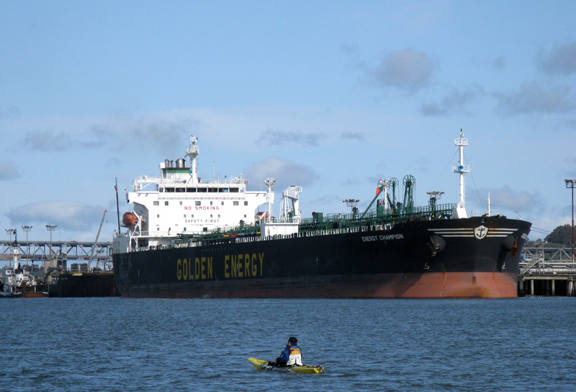 The
Peace Navy was picking up the baton in a long line of water-based
political activism. In 1958 the U.S. yacht Phoenix of Hiroshima sailed into
the forbidden Bikini Atoll nuclear test zone in the Pacific to protest
U.S. nuclear testing. Another vessel, the Golden Rule,
was stopped and its crew was arrested; it is currently being lovingly
restored with the support of Veterans for Peace. Four years later
Kaiser Permanente physician Dr.
Monte Gregg Steadman
and crew deliberately sailed their 38-foot ketch Everyman II from
Honolulu into the harm’s way of the Johnson Island atomic tests; their
ship was seized and the men held in contempt of court. More recent
examples
include Pete Seeger’s sloop Clearwater,
an icon for the ecological restoration of the Hudson River, and the
well-known efforts of Greenpeace's Rainbow
Warrior ships.
The
Peace Navy was picking up the baton in a long line of water-based
political activism. In 1958 the U.S. yacht Phoenix of Hiroshima sailed into
the forbidden Bikini Atoll nuclear test zone in the Pacific to protest
U.S. nuclear testing. Another vessel, the Golden Rule,
was stopped and its crew was arrested; it is currently being lovingly
restored with the support of Veterans for Peace. Four years later
Kaiser Permanente physician Dr.
Monte Gregg Steadman
and crew deliberately sailed their 38-foot ketch Everyman II from
Honolulu into the harm’s way of the Johnson Island atomic tests; their
ship was seized and the men held in contempt of court. More recent
examples
include Pete Seeger’s sloop Clearwater,
an icon for the ecological restoration of the Hudson River, and the
well-known efforts of Greenpeace's Rainbow
Warrior ships.During the Vietnam War, people used their boats to make their point. Quaker peace activist David Hartsough—an organizer of the 1983 AFSC demonstration, and Peace Navy member—recalls an action in 1972 at the Earle Naval Ammunition Depot in New Jersey:
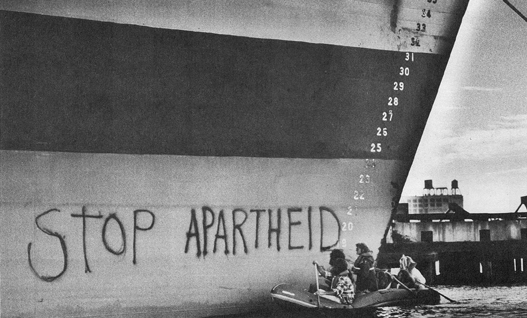
Since 1983, the Peace Navy has engaged in a rich variety of water-based guerrilla theatre dramatizing our opposition to U.S. Naval intervention abroad and support for ecologically sound, socially just, and peaceful uses of the Bay at home. Peace Navy founder Bob Heifetz put it this way:
Although our ability to mobilize on the water has declined in recent years, the Peace Navy has successfully occupied a niche in the political ecology with its vibrant cultural forms.
Our most consistent actions were organized against Fleet Week, a giant party held mid-October for the U.S. Navy and Marines sponsored by City of San Francisco and the Navy League. The Blue Angels, the Navy's exhibition team of F/A-18 Hornets, streak overhead and local dignitaries greet giant warships as they parade through the Golden Gate. It’s an enormously popular event.
The current incarnation of Fleet Week has only been around since 1981, when then-mayor Dianne Feinstein established it as an annual event. She was resurrecting the patriotic glory of Fleet Week, July 1908, when San Francisco proudly hosted President Teddy Roosevelt's "Great White Fleet" and provided an ample venue for crowing about our conquest of the Philippines. They still bring out the big gunboats, but the Peace Navy was there to counter the jingoism with singing children, giant banners, clever slogans, drum circles, and theater.
Who was our audience? During Fleet Week, we passed stands full of dignitaries, politicians, and the general public. We also came close to the Navy and Coast Guard ship crews and we’d occasionally get some press coverage (but rarely, Fleet Week was sacred to the media). We coordinated water-borne actions with our allies (such as AFSC, Greenpeace, and CISPES) on the shore, who handed out flyers to better explain why these unpatriotic wingnuts in a ragtag flotilla were ruining the parade.
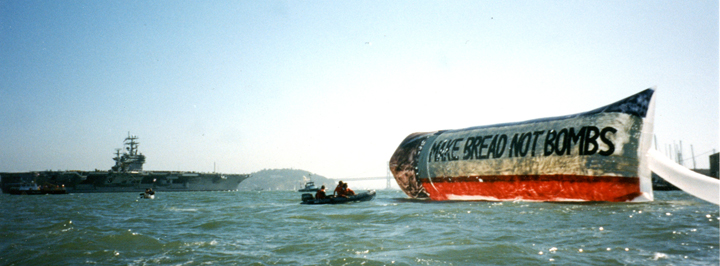
We were pushy. Perhaps our greatest legacy was a lawsuit that resulted in a landmark ruling that expanded the terrain of public demonstrations, Bay Area Peace Navy v. United States, 914 F.2d 1224, 1229 (9th Cir. 1990). We successfully challenged an arbitrary security zone that diminished the efficacy of water-borne protests. A legal summation of the case described it this way:
Our usual Fleet Week demonstrations amassed flotillas of small and large craft and focused on a different theme each year. Issues included the controversial homeporting of the battleship USS Missouri, the centennial of the Spanish-American War, and challenging the bloated military budget. But our most ambitious effort was in 1995, when we called attention to French nuclear testing in the South Pacific. Under the guidance of artist Richard Kamler, the Peace Navy built a huge (17” diameter and 75’ long) inflatable polyethylene loaf of French bread with the slogan “Make Bread Not Bombs.” My lead Peace Navy boat carried a gasoline-powered blower, and a Greenpeace Zodiac took care of guiding the display in front of the review stand. This was not an easy task; we had to coordinate both boats that were delicately linked by an inflation tube, and the giant loaf wanted to roll and blow downwind.
The Peace Navy engaged in other actions as well, both at the request of local organizations and on suggestion from our members. In 1983 we protested the U.S. invasion of Grenada, done under the pretext of saving American medical students, by launching our own invasion of Angel Island “to save the deer.” The next year we drew attention to the U.S. government's illegal mining of Nicaragua's harbors by symbolically "mining" the Alameda Naval Air Station with giant weather balloons. In 1985 we sailed a picket line by the Nedlloyd Kembla, a ship carrying goods from South Africa, in support of the longshoremen who were refusing to unload the ship's cargo. And in 1986 we joined fishermen and the ecology movement to give visual testimony opposing offshore drilling at a public hearing. In 2008 the Peace Navy joined with numerous activists and artist David Solnit to protest the Chevron oil refinery in Richmond, California.
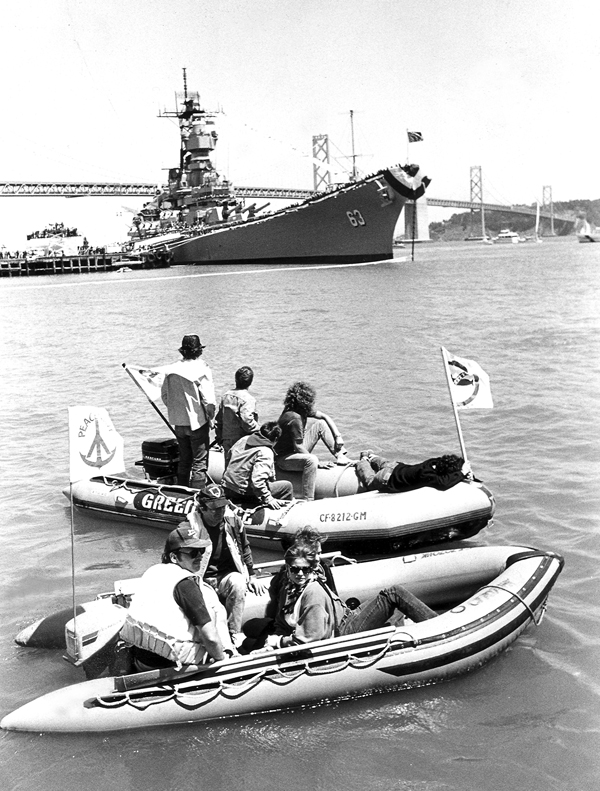
As the local military budget waned and bases closed, we figured that at least on the Fleet Week front we had “won.” Unfortunately, it continued as ever. In 2001 our dedicated commander Bob Heifetz passed away, further taking the wind out of our sails. It was not until the 2013 federal budget “sequestrations” that we saw the unprecedented (but temporary) elimination of the Blue Angels, Fleet Week’s most popular draw. Our op-ed in the East Bay Express, a local alt-weekly newspaper, outlined our challenge, comparing our Fleet Week unfavorably to another similar event:
The Peace Navy made, and may continue to make, a contribution to the
rich history of water-based social justice demonstrations. Movements
should draw upon activists from all quarters, and we mobilized people
who owned, or had access to, any form of watercraft. The logistics were
challenging and the barriers (including failed engines, contrary tides,
busy work schedules, and Coast Guard harassment) daunting. But our
efforts boosted morale of those engaged in land-based actions, and
provided one more channel to challenge a military-industrial status quo.
We hope that others help pick up the baton as we did in 1983. Remember,
you are only up the creek if you don’t have a paddle. And you can fight
fire with water.
More on the Bay Area
Peace Navy
Bay Area Peace Navy and Golden Rule sail
against the empire, SF Fleet Week 2015
External links - many no longer work and are disabled:
Seattle activists challenge
military role in SeaFair 2015
"Peace Pirates Community"
S.F. Bay Area, on Facebook 2015
Seattle
Kayaktivists battle deep sea oil drilling 2015
1962 documentary
film by Harvey Richards on the Everyman
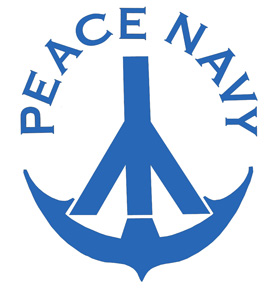
Photos:
1. The Peace Navy joined Direct Action to
Stop the War at Chevron's
Richmond Refinery to demand that Chevron stop contributing to global
warming, the war in Iraq, and releasing pollution in Richmond and
beyond. 2008.
2. One of two Peace Navy boats supporting an
ILWU picket of the Nedlloyd
Kembla, a Dutch freighter carrying South African cargo, 1986 (photo by
Mary
Golden).
3. Joint Peace Navy action with the local
Greepeace chapter. The inflated
“loaf of French bread” was used to protest French nuclear testing in
the Pacific, 1995.
4. Greenpeace and Peace Navy opposing
homeporting of USS Missouri, 1987. (Photo by Janet Delaney).
page last updated 10/4/2024